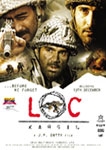 The word “crore” is Indian English for 10,000,000. (One crore = 100 lakhs.) I first encountered this word in articles about the Bollywood film industry. Bollywood writing has its own particular style that, like stuff on the E! Entertainment channel (e.g. “Bennifer“), is hard to understand if you don’t follow industry gossip regularly. Usually, crore is used to refer to how much money a film costs to make, or how much it earns in the box office. When Outlook India reported that Line of Control (L.O.C.) was loosing money, this is how they reported it:
The word “crore” is Indian English for 10,000,000. (One crore = 100 lakhs.) I first encountered this word in articles about the Bollywood film industry. Bollywood writing has its own particular style that, like stuff on the E! Entertainment channel (e.g. “Bennifer“), is hard to understand if you don’t follow industry gossip regularly. Usually, crore is used to refer to how much money a film costs to make, or how much it earns in the box office. When Outlook India reported that Line of Control (L.O.C.) was loosing money, this is how they reported it:
Like its lead men, LOC too died young. The big banner attempt at bringing tears to the eyes of a nation that is usually fond of mixing melancholy with popcorn flopped fast. In the words of the trade papers, the film that was sold at over Rs 3 crore per major territory is “somewhere between losing money heavily and becoming a disaster”. According to industry observer Komal Nahata, “every major distributor may lose close to Rs 50 lakh”.
But this is newsworthy, not just because of the language, but because it shows that Indian filmgoers don’t want to see nationalistic war movies. When this film, about India’s high altitude war with Pakistan played at our local (Pakistani owned) Bollywood movie theatre in Queens, the owners felt compelled to put up a warning sign that Pakistani viewers might find the film offensive. I guess Indian viewers did too.
Or maybe it was just a bad film? The question is an important one for the industry, because a whole host of films set against the backdrop of the battle in Kargil are due to roll out later in the year:
One down. The herds are panicking. For there are many more war films on the conveyor belt. Men who announced them proudly are feeling that cold prickle of fear. The moneybags are wondering if the sudden season of peace killed LOC. Goodwill is bad for those who want to make money out of killing Indian soldiers on the screen. “The producers are nervous,” says the director of a war film due for release this year. “They are just businessmen for whom films are like the stockmarket. They feel the Kargil stock has plummeted. They do not have the common sense to look at LOC for the rubbish film that it was”.
But if the Indian public hungers for films that aren’t rubbish, those in power seem equally keen to make sure that quality films never get seen. One film, the documentary Final Solution, was accepted at film festivals all over the world, but was rejected by the Bombay International Film Festival for documentary films:
Several documentaries that investigate the horrors of the brutal bloodshed that lasted for weeks in Gujarat in 2002 have been rejected by the film festival’s organizers, banned by India’s censorship board or faced threats from Hindu extremist groups.
Filmmakers claim that such instances raise important questions about freedom of expression and signal a growing intolerance in Indian democracy. They say their films about Gujarat are secular weapons in a fight against the rise of Hindu nationalism in mainstream Indian politics and national discourse in the past decade.
The only option left for viewers will be a return to typical Bollywood fare. As Outlook India reports:
So, as the story goes, in Bombay’s very famous industry, the ‘real men’ are all going to war till it becomes loss-making and they have to resort to love again.
